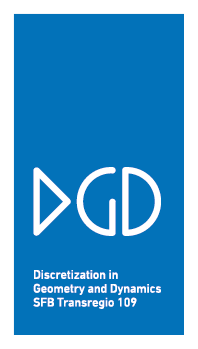Constant Mean Curvature Tori and Cylinders in Euclidean 3-Space
Nicholas SchmittMedia
Description
In the mid-twentieth century, Heinz Hopf showed that the only constant mean curvature surface of genus zero is a round sphere. On the other hand Pavel Alexandrov observed that every compact embedded constant mean curvature surface is a round sphere. The question naturally arose whether compact embedded constant mean curvature surfaces existed with higher genus. This question was resolved in the affirmative by the discovery of the the first constant mean curvature torus by Henry Wente in the mid nineteen eighties]. His work motivated a complete classifcation of constant mean curvature tori in terms of integrable systems, and continues to inspire research in the moduli space of higher genus constant mean curvature surfaces with and without ends.
One sequence of images shows what happens when one of the periods of a Wente torus is broken: the surface explodes into a periodic bubbleton. The sequence was constructed by following a flow through spectral genus 2 CMC cylinders, starting at a round cylinder. Two double points on the spectal curve were opened up to become branch points of the genus 2 spectal curve.
There is a flow through constant mean curvature (CMC) cylinders in euclidean 3-space with spectral genus 2 which reaches a dense subset of CMC tori along the way. Starting at a twizzler (equivariant CMC surface) with a straight-line axis, and opening up a double point at the Sym point, the flow bends the straight axis into a circular “soul curve” with shrinking radius, leading to a Wente torus. The flow is as in with closing conditions adapted to CMC cylinders in $\mathbb{E}^3$.
A Dobriner torus is a CMC torus with spectral genus 3 and rectangular conformal type, whereas the tight Dobriner torus is aconstant mean torus in euclidean 3-space with spectral genus 3. The surface was constructed by following a period-preserving flow through spectral genus 3 CMC tori in the 3-sphere, starting at a flat torus. Three double points on the spectral curve were opened up to become branch points of the genus 3 spectal curve. The flow was continued until the mean curvature became infinite, limiting to a CMC surface in euclidean 3-space.
The Rattlesnake tori are two examples of spectral-genus-three tori constructed by bending a straight spectral-genus-two cylinder.
Further images of tori of higher spectral genus from 4 to 6 are shown.
References
-
Uwe Abresch.
Constant mean curvature tori in terms of elliptic functions.
J. Reine Angew. Math., 1987.
URL: https://mathscinet.ams.org/mathscinet-getitem?mr=876223. -
Rolf Walter.
Explicit examples to the H-problem of Heinz Hopf.
Geom. Dedicata, 1987.
URL: https://mathscinet.ams.org/mathscinet-getitem?mr=892400. -
John Bolton, Franz Pedit, and Lyndon Woodward.
Minimal surfaces and the affine Toda field model.
J. Reine Angew. Math. 459, 1995.
URL: https://mathscinet.ams.org/mathscinet-getitem?mr=1319519. -
Nigel J. Hitchin.
Harmonic maps from a 2-torus to the 3-sphere.
J. Differential Geom. 31 no. 3, 1990.
URL: https://mathscinet.ams.org/mathscinet-getitem?mr=1053342. -
M. Kilian and M.U. Schmidt.
On the moduli of constant mean curvature cylinders of finite type in the 3-sphere.
preprint, 2007.
arXiv:0712.0108.
























